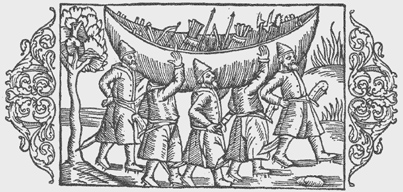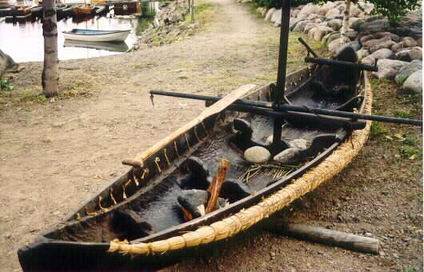The emperor Constantine Porphyrogenitus writes in his book from 952 AD that the Rus come along Dniepr to Contantinople (today's Istanbul and the Viking's Miklagard) in their "monoxyla", which they bring with them from the area of Smolensk and Novgorod. The Slavonic inhabitants make the bottoms of these "monoxyla" and sell them to the people of Rus, who fit them out for the journey.
It is evident from the text that the Rus had a Nordic stock. The Slavs were their subordinates.
The word "monoxyl" means a boat made of one tree trunk. This gives a light boat and explains how the Rus could past the barrages carrying their boats. The making and use of such vessels have survived in isolated areas of Finland, the Baltic States and Russia.
The ancient eastfarers used ships of the type Heimløsa Rus on the Baltic Sea. When continuing east on the Russian rivers they changed to dug out boats.
 | Bishop Olaus Magnus describes in his book from 1555 AD comrehensively the life of the Nordic people. To the left you see a vignette from his publication that shows how the Russians curry their dug out boat from one stream to another. |
As an marine-archæological experiment we, in 1996, together with our Estonian friends, built some dug out boats and with them made an expedition eastwards on the Estonian rivers and lakes. See report of our Finnish-Estonian dug out project.
The book of Porphyrogenitus tells also that the Rus, when they came to the Black Sea, equipped their monoxyla for the open sea. They rigged their dug out boats with sails and probably also added planks to the boat sides to increase the freeboard and put on some kind of outrigger to make the boat more seaworthy. The technique of sewing planks to a dug out boat is old and was used already in the Bronze Age. In the relatively well preserved Finnish Mekrijarvi find (15th century) there are 2 planks on both sides sewn with spruce roots to the 8 metres long dug out boat. See report of our Mekrijarvi dug out project.
| For the purpose to test how a dug out boat could have been used thousand years ago on the open sea we rigged our dug out boat Faravid (Faravid was the name of a Finnish Viking Age king) with a square sail and sailed her in the Raid Finland race in July 2002. Also one plank was added to each side by a seam of spruce roots as in the find from Mekrijarvi. We outrigged her by tying bundles of rush to the sides. It is known that this technique was used by the Cossacks on their big dug out boats on the rivers of Don and Dniepr and on the Black Sea in the 17th century. See more photos and separate report and test results from our sailing in Raid Finland 2002! |  |
| Main page of the Rus Project |